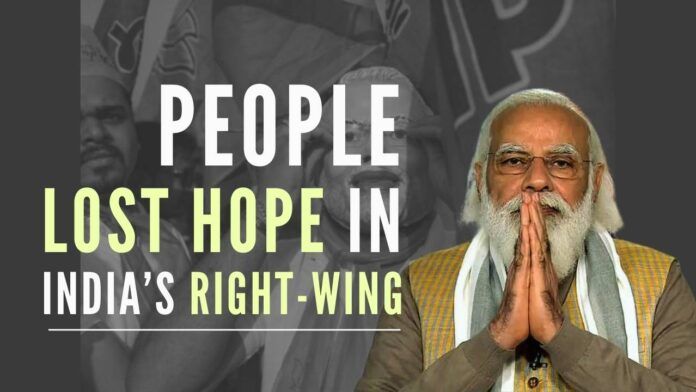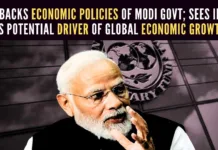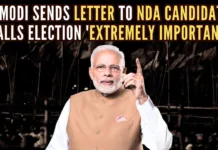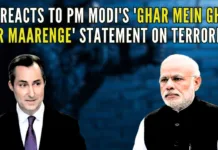
Bengal and Delhi riots were major reasons behind betrayal by right-wing Hindu-nationalist forces?
BJP’s rout in the Bengal election is generally remembered as an incident with tremendous electoral significance by Modi supporters and Modi haters. Modi supporters commonly referred to as “bhakts,” are as depressed as their election-obsessed hero over the colossal defeat as if the party’s victory was the full-proof guarantee to ward off the existential threats faced by the Hindu community from jihadi extremists, demographic change, and previous regimes’ appeasement politics. The Modi haters have found a new icon to rally around and a new narrative, though false, to contain or counter the so-called Hindutva forces. However, both the groups have clearly missed out on a dangerous signal, i.e., a clear manifestation of the most potent internal security threat with its natural fall-outs on external security that India is most likely to face in the future. So why people lost hope in India’s right-wing organizations?
The communal violence that followed the BJP’s rout mainly targeted Hindus, particularly those who supported and voted for BJP. Reportedly, the state government led by Mamata Banerjee was a mute spectator, as if allowing the jihadi extremists to seek revenge to their satisfaction. The local Hindus had to flee their homes, hide in jungles, fearing for their lives[1]. The state governor, frustrated with the state administration’s insubordination and hostile attitude, was seen in tears on TV, mentioning the deplorable plight of Hindus resulting from the communal violence. However, the most intriguing and disappointing part of the tragedy was the betrayal by India’s right-wing Hindu-nationalist forces. Hundreds of battalions of central paramilitary forces were deployed. Then, the Central government has an array of mighty, skilled, and resourceful intelligence agencies at its command. If the centre had the will, skill, vision, and courage, they could have predicted this violence and even stopped it.
Sir Sayyid Ahmad Khan, the original founder of the two-nation theory, continued to be adored and respected even in the Indian official diplomatic circles.
However, it is not just in Bengal that one witnessed the classic betrayal. The “betrayal” was quite evident in Delhi after the passage of the CAA/ NRC Act. The way Shaheen Bagh movement spiraled out of control and engulfed the entire country, with a plethora of international Jihadist, Khalistani, and other sabotage actors financing and coordinating the entire movement, made it explicit that either the Central government with all its security paraphernalia failed to perceive its long-term ramifications and control it, or they deliberately allowed it escalate to secure electoral gains in Delhi elections, oblivious of what it might lead to. The consequences, as we all know, came in the form of pre-meditated and orchestrated brutal communal riots in the capital city when the US President was on an official visit. It was not just a major embarrassment but also led to brutal killings and rapes of several innocent people.
Reactions of the right-wing
In many private conversations about the Bengal riots and Delhi riots, the senior members of right-wing nationalist organizations were found saying that “Hindus will have to fight for themselves against the jihadist elements; we cannot be there every time.”
Such reactions are not just random outbursts, which can be brushed aside. A closer look reveals patterns giving sufficient reasons to have a skeptical view about those ideological-cultural groups and political parties who make lofty claims to protect India from foreign expansionist forces, jihadi extremists, missionaries indulging in sabotage and conversion, ideological extremists, civil rights activists, and intellectuals peddling fabricated narratives about India’s cultural, philosophical and religious traditions. In the decade of 2000s, India witnessed a series of terrorist attacks across the country. In the last decade, all kinds of anti-India forces mentioned above strengthened under direct or indirect state patronage. Monks and saints were falsely fabricated in terrorism cases. School curriculum was manipulated to inject anti-India and anti-Sanatan sentiments. Murderous jihadists like Tipu Sultan were worshipped as heroes of the country. Sir Sayyid Ahmad Khan, the original founder of the two-nation theory, continued to be adored and respected even in the Indian official diplomatic circles.
Hence, when people brought a revolutionary shift in power at the Centre, they expected some ground-breaking interventions. However, PFI (Popular Front of India), an Islamist group that engineered Delhi riots, indulged in terrorist attacks, murders, radicalization, and has ties with ISIS (Islamic State of Iraq and Syria), Al-Qaeda, and Turkey, is still not a proscribed organization. jihadist elements in Kerala continue to have a free ride. Though CAA/ NRC was passed, made popular with loud rhetoric, and numerous debates may be to score electoral gains, nothing concrete has taken place to evict illicit Bangladeshi migrants and Rohingyas. In Jammu city, Kargil and Kashmir, Rohingya settlements are flourishing, and the state is missing in action, except for some superficialities.
The current government has not made any effort to counter babudom’s resistance and bring in changes in the recruitment system, education, and curriculum.
Moreover, how the government handled its external communications about CAA/ NRC getting unimaginable flak from the global diplomatic and human rights community has already made sure that government will think ten times before taking any action to evict illegal Bangladeshi migrants. Bengal also continues to be a jihadi hotspot. If the Centre was really serious about dealing with the national security issues, they could have imposed President’s rule in Bengal, sent a strong governor, and initiated robust action against extremist and terrorist elements, as there were sufficient conditions to justify invoking President’s rule. However, it seems that election victories were more important than the blood of innocent party workers, betrayed by their political heads and killed by jihadi extremists. Likewise, in Kashmir, perfunctory steps like a ban on Jamaat-i-Islami were taken. Loaded with immense symbolic value and high on optics, such moves garnered huge publicity and supplied enough material for heavy election rhetoric. However, very few people care that the entire Jamaat leadership is intact and working from rural areas. No harm came to them. Now they have strong links with global Islamist organisations like Muslim Brotherhood. They have strong ties with Turkey, which has emerged as India’s most ardent critique and opponent after the abrogation of Article 370. Reportedly, Jamaat is planning and preparing the fertile ground for massive internal sabotage with the help of its foreign benefactors. Jamaat proxies are still safe and flourishing in police, administration, academia, civil services, journalism, business, and cultural institutions.
Zakir Naik, a Jihadist ideologue, who constantly mocked Hindu gods, inspired the ISIS attack in Bangladesh, enjoying the blessings of Congress party leaders like Dig Vijay Singh, is understandable[2]. However, during the BJP government, if he absconds or, as many credible sources believe, was allowed to abscond, it is not easy to understand. It raises many questions about the sincerity, integrity and commitment of those people at the helm of affairs. Last year, Tableeghi Jamaat was all over the news for its role in Covid spread and ties with jihadist entities. Its chief, Maulana Saad, was declared an absconder. However, almost a year has passed, one hardly comes across any concrete action against the organisation. Likewise, no substantial progress has been made in the regularisation and scrutiny of madrasas. The population bill appears to have been kept in abeyance for some light years.
Further, systemic and institutional changes, expected, are nowhere to be seen. First and foremost, the civil service reforms, it seems, will never see the light of the day. India’s intelligence apparatus continues to be manned by bureaucratic, under-performing police officials selected from an archaic and outdated colonial examination system. They have an extremely poor understanding of India’s existential threats like jihadism and China and incompetence to execute any countermeasures to address these challenges. Nurtured and fed with pseudo-secular and liberal overdose, most of them continued to pamper anti-nationals and jihadists in Kashmir on the pretext that India is a multicultural nation and to prevent alienation, we have to keep the jihadi extremists happy. Imagine, Pulwama happened, China attacked Ladakh, and not a single top-level intelligence professional was suspended. Indian diplomats, over the last two decades, advocated CBMs and boundary protocols with China. Even after Doklam, their failure to understand China’s real motives continued and resulted in Wuhan and the Chennai spirit. Indian civil bureaucracy and diplomats, especially the post-1990 entrants, are reviled for their incompetence, poor domain knowledge, and corruption. However, their most damaging shortcoming is that their entire understanding, training, and education are rooted in western narratives and theoretical structures. Their awareness and respect for India’s indigenous strategic thoughts, intellectual and cultural traditions are highly inadequate. Hence, they are not fit to secure India’s interests. Unfortunately, the current government has not made any effort to counter babudom’s resistance and bring in changes in the recruitment system, education, and curriculum.
Wallowing in the falsehoods
If any right-wing nationalist politician or ideologue is asked a question about India’s partition – they will not skip a second in criticizing Jinnah and his two-nation theory. Right after that, you are encountered with the concept of “Akhand Bharat.” However, when their notions are dissected on the logical ground, they face irreconcilable inconsistencies. Mr Ram Madhav’s famous interview with Mehdi Hasan is an excellent example. When Mehdi Hasan asked him about “Akhand Bharat,” for a moment, he was clueless and speechless[3]. Then, after a while, he came up with the idea that it’s a cultural concept. The question here is the stand of right-wing forces on the issue of partition and the actors involved. If they oppose India’s partition, what do they mean by that?
In today’s India, 14% Muslims and 81% Hindus cannot live peacefully. We have to agree that deep-rooted historical, cultural, and religious problems exist between the two communities. Before partition, there were massive communal riots in Kerala (1920-21) (when RSS was not even formed). In the 1880s, Sir Sayyid Ahmad Khan was talking about Muslim separatism. Muslim League formed in 1906 demanded separate electorates. The 1930s and 40s saw brutal communal riots. Bloody riots and murders of thousands accompanied partition. Post-partition, we saw Gujarat riots (1969), Bhagalpur riots (1985), Assam riots, Gujarat (2001), and Muzzaffarnagar riots. Besides, there are minor or major incidents of communal riots in congress, BJP, communist, Samajwadi, BSP, and all other governments. Whatever we may say, India has major issues between Hindus and Muslims. If the right-wing forces oppose India’s partition, one has to imagine a hypothetical situation of undivided India. It is not a pleasant idea to imagine India, Pakistan, and Bangladesh united. Such an entity would have been an administrative disaster and a hotbed of massive communal riots.
Further, India would have become a focal point of jihadism, a South Asian Regional Jihadist headquarters with all the prominent Islamic fundamentalist schools headquartered in India. The composition of the Indian parliament of United India would have had an overwhelming number from the Muslim community, with extremist clerics sitting in the parliament. Moreover, India would have been fast approaching towards Sharia governed society through parliamentary resolutions and acts. This author would like to ask a few questions to Indian right-wing leaders when they adore Gandhi and despise Jinnah-
Was Jinnah wrong in understanding that Hindus and Muslims have major historical, cultural, and religious issues and constitute two separate nations?
Was he wrong in proposing a two-nation solution?
Will, our right-wing leaders, agree to live in the hypothetical society and polity of undivided India discussed above?
I am sure; if they argue logically, they cannot disagree with my answers to the questions posed above. If they cannot manage 17 crores Muslim minority, should not one question their sanity when they regret India’s partition or criticize Jinnah?
The change of narratives, historical discourse, and academia has to begin from the fundamentals. One has to question and understand Gandhi, Nehru, Patel, Jinnah, Malviya, Rajendra Prasad, and others in an objective and intellectual manner? A few questions that one needs to revisit:
- Were we or are we secular at an individual and societal level? A quick glance at the figures of communal riots since 1947 or before in rural and urban areas is sufficient to provide an objective answer.
- Suppose Gandhi and Nehru had accepted Jinnah’s two-nation theory, discussed with him to implement the partition plan amicably, would we have avoided the communal carnage that happened during the partition and after that?
- If both the countries had agreed to complete transfer of population and if India had handed over all the Muslim majority areas to Pakistan, would the two countries have been at peace?
- Was the transfer of population possible peacefully if the nation’s leaders had shown some wisdom?
Unfortunately, one hardly comes across a significant academic initiative in history, politics, strategic studies, which was expected of the regime that came to power in 2014 and stated that India has been under foreign control for the last 1200 years.
Conclusion
In the current scenario, the Shaheen bagh fiasco and Bengal communal carnage has emboldened the jihadist elements and completely demoralized those elements, which brought the current regime to stop appeasement, protect India’s secularism, democracy, and its cultural and religious identity. The jihadist elements and their international benefactors (both and state and non-state actors) feel that if India’s most powerful government, which came with the promise of rock-solid commitment to India’s security, lacks a long-term vision and is confined to superficialities, constitutional and long-drawn cosmetic legal measures, loud TV debates, the privileges and perks of power and petty electoral wins then their way ahead is easy and smooth.
With a proper strategy, commitment, and dedication aided by India’s right-wing-led state’s weakness, opportunism, short-sightedness, and timidity, the jihadist ecosystem hopes to bring major changes in India’s society and polity, maybe in two or three decades. Highly charged and polarized rhetoric on social media and mainstream media, engineered to create an appropriate narrative for electoral victory, will further guarantee that jihadist ideologues get enough local recruits and a safe ground to establish local units of the global Islamist outfits.
But, undoubtedly, those changes will not be a pleasant experience for those who believe in democracy, debate, openness, gender rights, peace, religious diversity, and tolerance.
Note:
1. Text in Blue points to additional data on the topic.
2. The views expressed here are those of the author and do not necessarily represent or reflect the views of PGurus.
References:
[1] 80,000 forced to abandon homes in Bengal: BJP chief J P Nadda – May 06, 2021, ToI
[2] Why Zakir Naik’s publicity mechanisms deserve to be banned – Jul 30, 2016, BD News 24
[3] Head to head with hate – Jan 02, 2016, Daily O











Can a Hindu go & attack another Hindu? Can a Muslim go & attack another Muslim? To the best of my understanding, no one can attack any one physically.
Does Sun shines the same way or differently on Hindus Muslims Christians or does he discriminate between good & bad people? It is DHARMA. Dharayatee iti dharmah. Trees give fruits to everyone not just to those who water them. Human beings must be DHARMIC. LAW ABIDING if I may say to suit modern times.
Whenever there are riots or such physical attacks, POLICE are supposed to act immediately & spontaneously to defuse the situation, make arrests & file court cases. Why aren’t they doing it? Because they have no freedom to act. They have to act as per the diktat of their political bosses. Bottom line is there is no FEAR OF LAW in these people engaging in acts of violence, killing or hurting fellow human beings.
It is not in Bengal alone, we have seen violence in Tamilnadu, Andhra Pradesh, Telangana, Kerala, Maharashtra, Rajasthan, UP, MP, Bihar, Gujarat everywhere barring one or two states under the CHARADE of religion.
No Hindu leader, No Muslim leader or no Christian leader are truly bothered about the followers of their religion/faith. The only objective of these politicians is to make money, remain in power, engage in pleasures, all qualities of RAKSHASAS
We have CONSTITUTION – We have CONSTITUTIONAL INSTITUTIONS – We have POLICE – We have COURTS
For whom? It is high time POLICEREFORMS are brought in & POLICE be made to function independently than under state Governments.
God has a tool – DEATH (To both Good / Bad people because good people can become bad if they have no DEATH) What do we people have to LIMIT TENURES OF INDIVIDUALS HOLDING AN OFFICE OF LEGISLATURE TO 2 TERMS OR 10 YEARS?
GOD BLESS INDIA